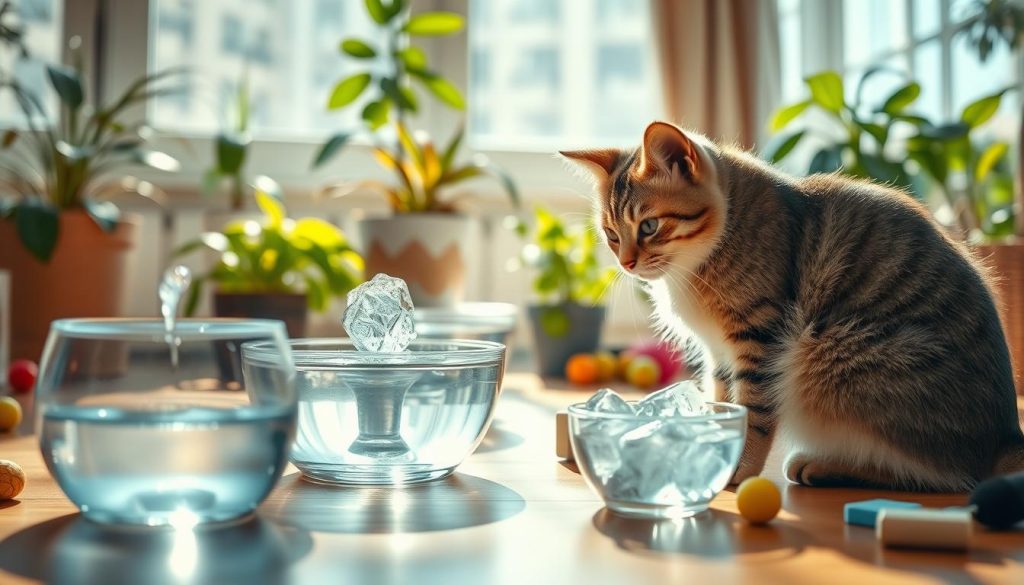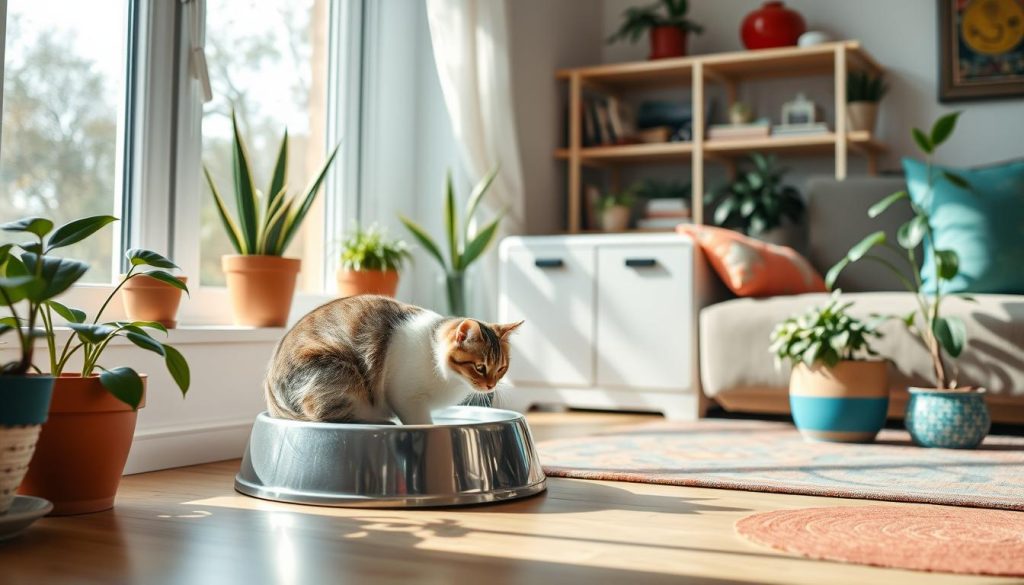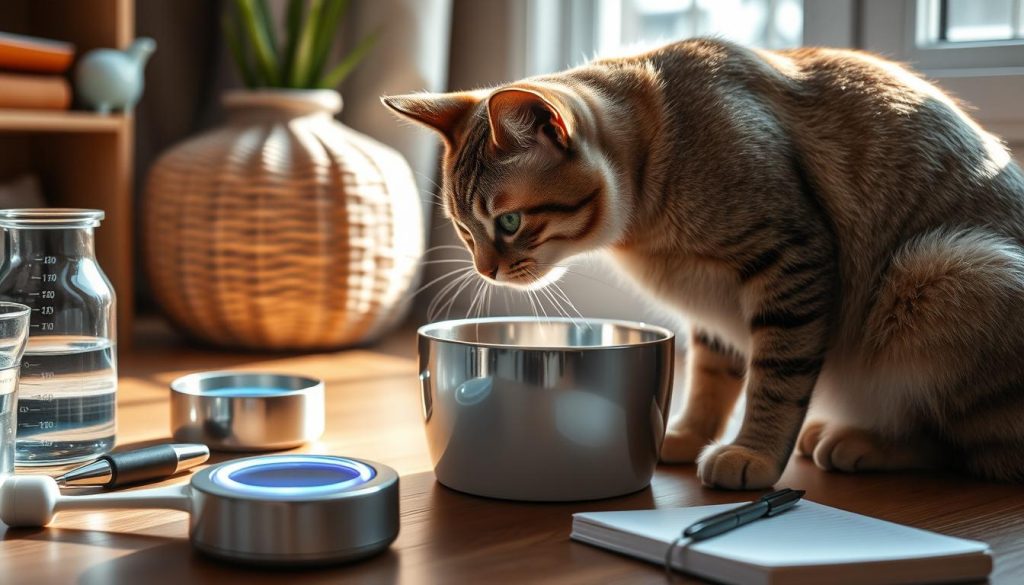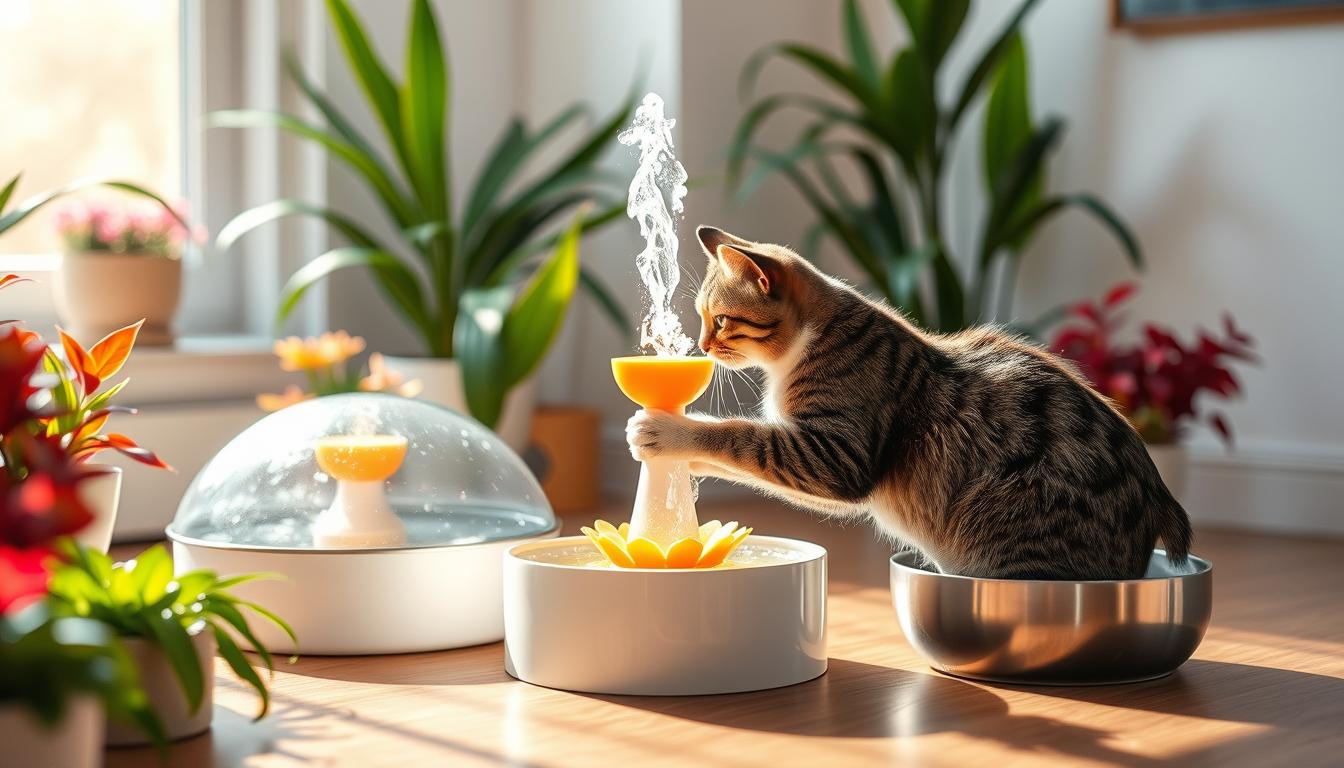As a devoted cat owner, I always put my feline friend’s health first. Ensuring they drink enough water is key. In this guide, we’ll look at dehydration signs, health risks, and ways to get your cat to drink more.
Cats can easily get dehydrated, which is bad for their health. Knowing how to keep them hydrated is crucial. By following some simple tips, you can help your cat stay healthy and happy.
Understanding the Importance of Hydration for Felines
https://www.youtube.com/watch?v=5Usapkahhik
Keeping your cat hydrated is key to their health. Cats need the right amount of water to stay in top shape. Knowing how to spot dehydration and its dangers is vital for cat owners.
Signs of Dehydration in Cats
Spotting dehydration in cats is the first step to meeting their cat hydration needs. Look for signs like being very tired, dry mouth, and skin that doesn’t snap back quickly. Also, watch for sunken eyes. If you see these signs of cat dehydration, it’s time to get your cat some water.
Health Risks Associated with Inadequate Water Consumption
Not drinking enough water can harm your cat’s health. Dehydration can cause kidney problems, urinary infections, and constipation. It can also make kidney disease or bladder stones worse. Watching your cat’s water intake and acting fast can prevent these issues.
Knowing how important water is for cats and spotting dehydration helps owners keep their pets healthy. Always watch your cat’s water intake and adjust it as needed. This is crucial for their health.
Factors Influencing Your Cat’s Water Intake

As a cat owner, it’s important to know what affects your cat’s water intake. This knowledge helps keep your cat healthy and hydrated. Age, activity level, diet, and environment all play a part in how much water your cat needs.
Kittens and senior cats need more water than adult cats. This is because their bodies work differently. Active cats also need more water to replace what they lose during play or exercise.
- Diet composition: Cats on dry food need less water because their food helps with hydration. Cats on wet food may need less extra water.
- Environmental factors: The weather where your cat lives affects their water needs. Cats in hot or dry places need more water to stay hydrated.
- Health conditions: Some health issues, like kidney disease or diabetes, can change how much water a cat drinks. This can make them drink more or less than usual.
| Factor | Impact on Water Intake |
|---|---|
| Age | Kittens and senior cats generally require more water |
| Activity Level | Active cats need more water to replenish fluids lost through exercise |
| Diet Composition | Cats on dry food diets tend to have lower water intake |
| Environmental Conditions | Warmer or drier climates may increase a cat’s water needs |
| Health Conditions | Certain medical issues can affect a cat’s ability to regulate water intake |
By understanding these factors, you can make sure your cat stays hydrated. Adjusting their water access and intake helps keep them healthy.
Strategies to Encourage Increased Water Consumption

As a dedicated cat owner, it’s important to keep your feline friend hydrated. This is key for their health and happiness. There are many ways to encourage your cat to drink more water. Let’s look at some effective strategies to keep your cat’s water intake up.
Providing Multiple Water Sources
One great way to get your cat to drink more is to have multiple water sources. Cats like to have water in different places. So, put water bowls in rooms like the living room, kitchen, and bedrooms. This makes it easy for your cat to find water wherever they are.
Using Appealing Water Bowls and Fountains
The type of water bowl or fountain you use matters a lot. Choose bowls made of ceramic or stainless steel, as cats often prefer these over plastic. Also, consider a cat water fountain. The moving water can make your cat more interested in drinking. A fountain provides fresh, oxygenated water and helps your cat drink more.
| Water Bowl Material | Pros | Cons |
|---|---|---|
| Ceramic |
|
|
| Stainless Steel |
|
|
| Plastic |
|
|
By using these strategies, you can help your cat stay hydrated and healthy. Remember, keeping your cat well-hydrated is a big part of being a responsible pet owner.
Cat Water Intake: Monitoring and Adjusting as Needed

Keeping your cat hydrated is key to their health. Watching how much water they drink and adjusting as needed is important. Here’s how to keep track and manage your cat’s water intake.
Tracking Your Cat’s Water Intake
Start by watching how much water your cat drinks. You can do this by observing their habits and keeping a record. Here are some tips:
- Measure the water in your cat’s bowl at the start and end of each day.
- Notice if your cat drinks more or less water than usual.
- Watch how often and long your cat drinks.
Adjusting Water Intake as Needed
After tracking, you can adjust your cat’s water intake. You might need to:
- Put more water bowls around the house to encourage drinking.
- Try different water bowls or fountains to see what your cat likes.
- Change your cat’s food to include more water.
The right amount of water for cats depends on their age, activity, and health. By watching your cat closely and making smart changes, you can help them stay hydrated. This is good for their overall health.
| Indicator | Optimal Daily Water Intake |
|---|---|
| Adult Cat | 20-40 ml per kg of body weight |
| Kitten | 45-60 ml per kg of body weight |
| Nursing Cat | Up to 100 ml per kg of body weight |
Addressing Common Challenges in Hydrating Your Cat
As devoted cat owners, we often face the challenge of getting our feline friends to drink enough water. Some cats can be very picky about their water, making it hard to keep them hydrated. But, with a few strategies, we can help our cats stay healthy and hydrated.
Dealing with Fussy or Picky Drinkers
Cats can be notoriously picky when it comes to their water sources. They may turn up their noses at a perfectly good bowl of fresh water. But, there are a few tricks we can try to entice even the most reluctant drinkers.
- Experiment with different bowl materials and shapes. Some cats prefer drinking from ceramic, stainless steel, or even glass bowls, while others may be drawn to the sound and movement of a water fountain.
- Try placing multiple water stations around the house. Cats often prefer to have options, and having water available in several locations can encourage them to drink more.
- Add a few ice cubes to the water bowl. The cool temperature and gentle movement can make the water more appealing to some cats.
- Introduce flavored or infused water. A small amount of low-sodium broth or tuna water can make the water more enticing for fussy felines.
By experimenting with different approaches, you can find the right combination to overcome your cat’s reluctance. This ensures they stay hydrated and healthy. Remember, patience and persistence are key when dealing with picky drinkers.
Environmental Considerations for Optimal Hydration
The environment where your cat lives is key to their hydration. Knowing how surroundings affect their water intake is vital for their care.
Temperature and humidity levels matter a lot. Cats drink more in warm, dry places to replace lost water. Adjusting their water access based on these factors can prevent dehydration.
Having clean, fresh water available is also crucial. Offer multiple water bowls or fountains around the house. Place them in quiet spots to make your cat feel safe while drinking.
| Environmental Factor | Impact on Cat Hydration | Recommended Approach |
|---|---|---|
| Temperature | Higher temperatures lead to increased water needs to maintain hydration. | Ensure ample access to clean, fresh water and consider providing additional water sources in various locations. |
| Humidity | Low humidity can cause cats to lose more water through evaporation, leading to dehydration. | Monitor humidity levels and adjust water accessibility accordingly to meet your cat’s increased hydration needs. |
| Water Accessibility | Cats may be less inclined to drink if water sources are not easily accessible or located in busy, high-traffic areas. | Strategically place multiple water bowls or fountains in quiet, comfortable areas of your home to encourage increased water intake. |
Understanding environmental factors that affect your cat’s water intake is crucial. By addressing these, you can ensure your cat stays hydrated and healthy.
When to Seek Veterinary Assistance for Hydration Issues
As a cat owner, knowing when to get vet help is key. You can try to get your cat to drink more at home. But, there are times when a vet visit is necessary.
Look out for signs of severe dehydration like sunken eyes, being very tired, or skin that doesn’t bounce back. These could mean a serious health problem that needs quick attention. Also, if your cat’s water drinking habits change a lot, it’s a good idea to see a vet.
If you’re worried about your cat’s hydration or health, don’t wait. A vet can check your cat, find any problems, and help fix them. This way, your cat can stay healthy and happy.

